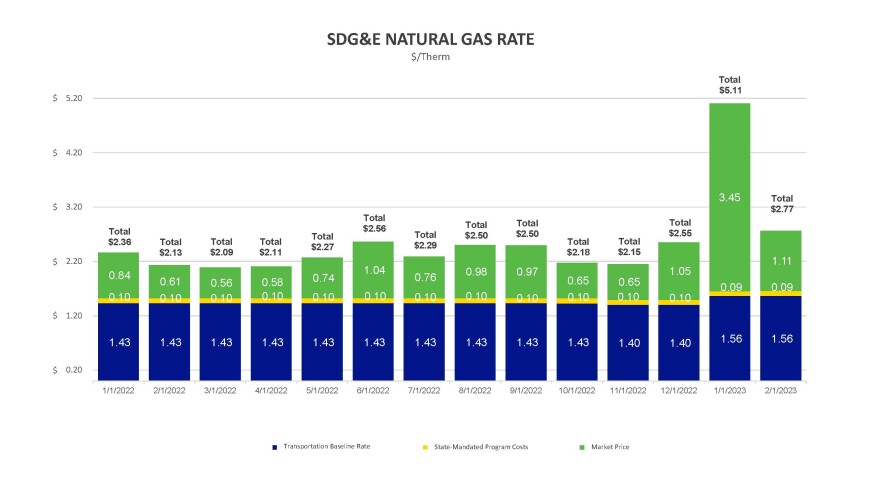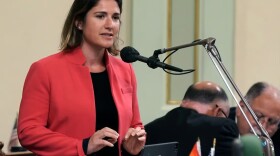Editor's note: This is second story in a two-part series. Read part one here.
January’s natural gas bills from San Diego Gas and Electric (SDG&E) were eye openers for many local residents, but few got the surprise Jack Babbitt did: His first bill of 2023 was $1,282.53.
The utility had been warning for months this past fall that natural gas bills would be more expensive because of colder-than-normal temperatures and a tight supply of the commodity.

The cost of natural gas in January hit $5.11 a therm — the unit of heat used to measure gas usage. That price was double the December rate.
And while it was pretty cold in the Fallbrook valley where Babbitt’s trailer home sits, it was not that cold.
The widower and Navy veteran had questions.
“Nobody follows the rules better than Jack,” said Douglas Gastélum, who is Babbitt’s grandson. “(He's a) retired Navy chief. He’s used to taking orders and he’s used to doing what needs to be done. But he’s also used to things being in order.”
Gastélum called SDG&E after the big bill and the utility told him the numbers were accurate and nothing else was done.
So Gastélum took a closer look at old bills and he found the nine bills before January were estimated bills and most had therm usage in the single digits.
Babbitt’s bills are estimated because his home, like his neighbors in the valley, has an analog gas meter that can only be read if someone actually comes out to the property.
SDG&E said that’s supposed to happen every other month.
“The bill says that there were nine estimates in a row. But in reality, we went to Mr. Babbitt's home two or three days after we sent him the bill.” said Anthony Wagner, a communications manager at SDG&E. “And that happened several times. So, while the bill identified an estimate. In reality, truthfully we missed one estimate and that was in November.”
It is an explanation Gastélum still struggles with.
“They told me that … they did estimates,” Gastélum said. “Yes, it says we did estimates for all these months, but really we sent someone out to really read the meter a few days after the estimate. Ah, which just doesn’t make sense to me.”
Estimated bills showed much lower gas consumption in the months leading up to January when usage was 274 therms.
“He had a legitimate frustration,” Wagner said. “And there’s no doubt, once there was human intervention that we could have done better.”
KPBS contacted SDG&E on June 27 and pointed out the issue of estimates in the bills.
“And we have attempted to work with KPBS to work with Mr. Babbitt’s grandson in order to make it right,” Wagner said.

The utility conceded the high gas usage in the months before the January bill was not accounted for in the algorithm that determined the estimated readings.
“In October, November, December he actually used 274 therms. But it charged him the 274 therms when the rate was the highest, in January at $5.11 cents,” Wagner said.
That rate was more than double December’s natural gas rate of $2.55 a therm.
It also means gas used in months with sharply lower rates got billed during the month with the utility’s highest-ever rate.
Two days after KPBS brought the oversized bill and the estimated readings to the utility’s attention, SDG&E inspected Babbitt’s home.
“We forensically looked at Mr. Babbitt’s bill,” Wagner said.
That review prompted the utility to recalculate the January bill, spreading the gas usage over the previous three months. The result was a $351 bill credit.
“And then we went out to the home and checked each appliance,” Wagner said. “We shut off each appliance so that no gas was going to the home and then we checked the meter to ensure the meter was not registering a leak somewhere.”

Gastélum had already found a faulty heating duct three months after the big bill landed, and that likely contributed to the unusually high natural gas usage. SDG&E technicians also turned down the water heater temperature in an effort to control future gas use.
Babbitt got information about low-income and medical bill assistance and he was promised the utility would bring in a third-party contractor for a complete home energy audit.
“We did everything within our power to ensure that his bill was accurately addressed,” Wagner said. “And we signed Mr. Babbitt up for other programs to defray the future cost of his bill. But we care. We get it. And we could’ve done better.”
Gastélum appreciated the bill credits, home inspection and information about ways to control gas bills in the future. But he’s disappointed he couldn’t get the same response on his own.
“We should not have had to talk to (KPBS) to get the right result,” Gastélum said. “We should’ve been able to do that by talking to SDG&E.”
Gastélum looks forward to the energy audit and he hopes future bills are smaller and rely less on estimates, so Babbitt isn’t hammered by an oversized bill next winter.







